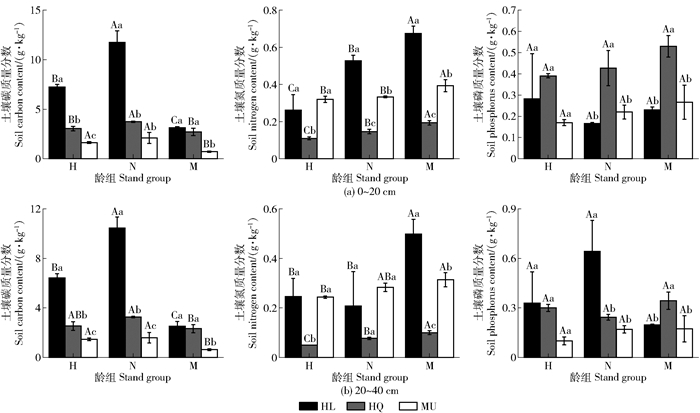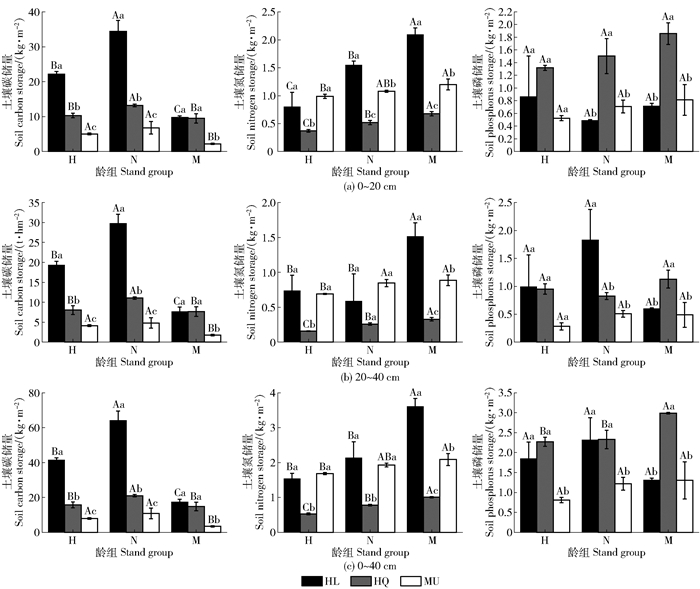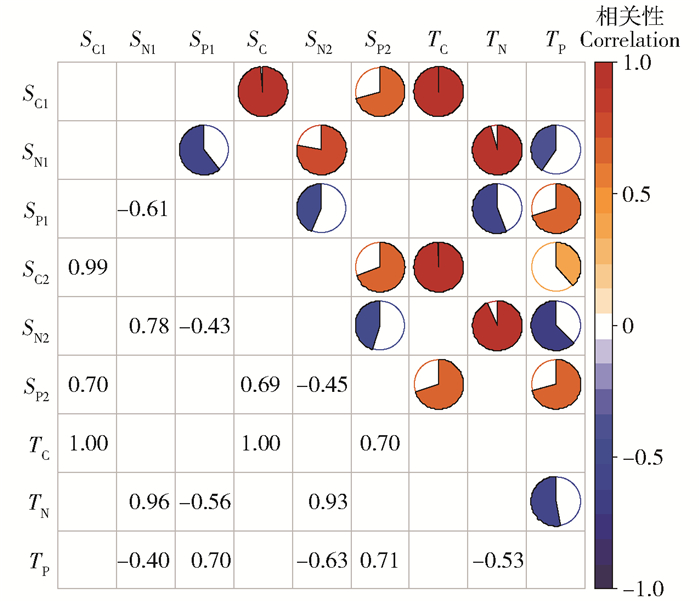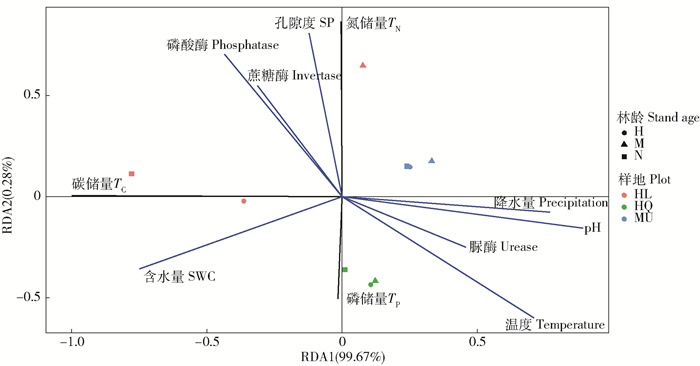2. 北京林业大学林业生态工程教育部工程研究中心, 100083, 北京;
3. 北京林业大学水土保持国家林业和草原局重点实验室, 100083, 北京;
4. 宁夏盐池毛乌素沙地生态系统国家定位观测研究站, 751500, 宁夏盐池;
5. 鄂尔多斯市林业和草原事业发展中心, 017010, 内蒙古鄂尔多斯
中国水土保持科学  2021, Vol. 19 2021, Vol. 19  Issue (6): 27-34. DOI: 10.16843/j.sswc.2021.06.004 Issue (6): 27-34. DOI: 10.16843/j.sswc.2021.06.004 |
土壤碳(C)、氮(N)和磷(P)是表征土壤肥力和生产力的重要指标,对调节植物生长和驱动养分循环具有关键作用[1]。其中,森林土壤有机碳是全球碳循环的重要组成部分,其储量约占全球土壤碳储量的73%[2];土壤氮、磷储量深刻影响着森林生态系统的净初级生产力和功能[3];因此,研究森林土壤碳氮磷储量对于深入理解森林生态系统功能和可持续经营管理有重要意义。
土壤碳氮磷储量存在较强的空间异质性和时间变异性[4]。气候可以通过各种直接和间接的生态过程影响土壤碳氮磷储量。降水改变土壤含水量,抑制或促进土壤微生物和酶的活性,进而影响土壤有机质分解和积累平衡[5-6]。海拔和温度也通过影响土壤含水量及土壤密度间接对土壤碳氮磷储量产生影响。此外,林龄可以影响植物-土壤的反馈调节,是土壤碳氮磷储量的重要影响因素之一[7]。随着林分生长,凋落物数量和分解的养分返还量均不断增加。根系分泌物是土壤养分的主要来源之一,其分布也会直接影响土壤有机碳的垂直分布[8]。植物干物质合成累积量随着林龄增加逐渐减少,生产力的不断下降降低了植物对土壤养分量的需求,土壤养分储量呈上升趋势[9]。
沙地樟子松(Pinus sylvestris var. mongolica)具有耐寒、耐旱、耐贫瘠等特性,是干旱半干旱区防风固沙、水土保持和速生用材的优良树种[10]。20世纪中期以来,沙地樟子松人工林广泛营建于我国北方多个沙区[11]。由于种植地区和年限不同,沙地樟子松林土壤碳氮磷储量可能存在较大差异,而对樟子松土壤碳氮磷储量的相关研究多仅集中某一地区[5, 12]。鉴于此,笔者以呼伦贝尔沙地、科尔沁沙地和毛乌素沙地中龄、近熟和成熟樟子松人工林为对象,通过分析土壤碳氮磷储量特征以及土壤特性和气候的相关性,探究引种地区和林龄对沙地樟子松林土壤碳氮磷储量分布的影响,以期为沙地樟子松人工林可持续经营管理提供理论依据。
1 研究区概况研究区分别位于内蒙古自治区红花尔基樟子松国家森林公园、辽宁省章古台沙地森林公园和陕西省红石峡沙地植物园。
红花尔基樟子松森林公园位于呼伦贝尔沙地东南部(E 115 °31′,N 47 °05′),海拔606 m。半湿润大陆性季风气候,春季干燥多风,夏季高温多雨,秋季温凉短促,无霜期90 d左右。年均温度仅为-0.4 ℃,年均降水量359.4 mm,年蒸发量1 174 mm,年均日照时间为2 558.6 h。土壤为风沙土,养分含量较低。优势植物种主要有樟子松、白桦(Betula platyphylla)、小叶锦鸡儿(Caragana microphylla)和沙蒿(Artemisia desertorum)等。
章古台沙地森林公园位于科尔沁沙地东南部(E 122°22′,N 42°23′),海拔226 m。中温带亚湿润大陆性季风气候,干旱多风,且侵蚀性风力集中,光照充足,昼夜温差大,无霜期超过150 d。年均降水量526.5 mm,降雨多集中在6—8月,年蒸发量1 932.7 mm,年均温度8 ℃,年均日照时间为2 615.2 h。土壤类型为风沙土,有机质及其他养分浓度较低。优势植物种主要有樟子松、胡枝子(Lespedeza bicolor)和赖草(Leymus secalinus)等。
红石峡沙地植物园位于毛乌素沙地东南部(E 109°42′,N 38°20′),海拔1 100 m。暖温带大陆性季风气候,干燥多风,冬、春季风沙较大,降水年际变化率大。年均温度9.1 ℃,年均日照时间为2 914 h,年均降水量365.7 mm,年蒸发量为2 502 mm。土壤类型为风沙土通透性好,保水性差,相对贫瘠。优势植物种主要有樟子松、紫穗槐(Amorpha fruticosa)和花棒(Hedysarum scoparium)等[10]。
2 材料与方法 2.1 样品采集与分析笔者于2017年沙地樟子松生长旺盛期7—9月进行野外调查与样品采集工作。以中龄(21~30 a)、近熟(31~40 a)和成熟(41~50 a)3个龄组的沙地樟子松人工林为研究对象,在每个林龄内随机布设3个样方,并选取3株标准木,样方面积为20 m×20 m。在树木基部周围清除枯落物层后挖掘土壤刨面,按0~20和20~40 cm深度分层收集土壤样品,混匀带回实验室。环刀采集的土壤样品用于测定土壤密度。
土壤样品在通风处风干并挑出细根和石块等,研磨后过100目筛。有机碳浓度采用重铬酸钾氧化稀释热法,土壤样品用硫酸-高氯酸消煮后,全氮浓度采用靛酚蓝比色法测定,全磷浓度采用钼锑抗比色法测定。环境因子的测定中,土壤含水量(soil water content,SWC)、孔隙度(soil porosity,SP)采用烘干法测定,pH使用pH计测定(土水比为1 ∶2.5)。另一部分土样带回实验室冷冻保存,用于测定土壤酶活性,土壤蔗糖酶、脲酶和磷酸酶使用多功能酶标仪测定[13]。
2.2 数据处理土壤碳(氮,磷)储量计算公式为:
| $ \begin{gathered} S_{\mathrm{C}(\mathrm{N}, \mathrm{P})_{i}}=c_{i} \rho_{i} d_{i} / 10 ; \end{gathered} $ | (1) |
| $ T_{\mathrm{C}(\mathrm{N}, \mathrm{P})}=\sum\limits_{i=1}^{n} c_{i} \rho_{i} d_{i} / 10。$ | (2) |
式中:SC(N,P)i为第i层土壤碳(氮或磷)储量,kg/m2;ci为第i层土壤碳(氮或磷)质量分数,g/kg;ρi为第i层土壤密度,g/cm3;di为第i层土层厚度,cm;TC(N, P)为土壤0~40 cm碳(氮或磷)总储量,kg/m2。
气象数据(温度和降水量)均来自于中国气象数据网。采用SPSS 26.0软件对数据进行统计分析,Origin 2018软件和R 4.0.3绘图。采用单因素方差分析法(one-way ANOVA)分析不同地区相同龄组和相同地区不同龄组间沙地樟子松土壤碳氮磷浓度、储量间差异(α=0.05),采用嵌套双因素方差分析法分析地区、林龄及其相互作用对土壤碳氮磷浓度和储量的影响(α=0.05)。采用Pearson相关系数分析不同深度土壤碳氮磷储量之间的相关性,RDA分析法用于分析环境因子对碳氮磷储量之间的相关性。
3 结果与分析 3.1 沙地樟子松林土壤碳氮磷浓度特征研究区不同龄组沙地樟子松林土壤有机碳、全氮和全磷质量分数分别为0.63~11.73、0.05~0.67和0.1~0.64 g/kg(图 1)。0~20 cm土层碳、氮质量分数均高于20~40 cm,磷质量分数差异不明显。毛乌素沙地土壤碳质量分数显著低于其他2个研究区(HL:80.4%,HQ:53.8%)(P < 0.05)。科尔沁沙地中龄林和成熟林氮质量分数显著低于其他2个研究区(P < 0.05)。随着林龄的增加,土壤碳质量分数均先增加后减少,最大值出现在近熟林,氮质量分数逐渐增加。地区对碳氮磷质量分数均有显著影响(P < 0.05),林龄对土壤碳氮磷质量分数(除20~40 cm土层磷质量分数)有显著影响(表 1)。

|
HL、HQ、MU表示呼伦贝尔、科尔沁和毛乌素沙地,H、N、M表示中龄林、近熟林和成熟林;不同大写字母表示同一地区不同龄组间差异显著,不同小写字母表示不同地区同一龄组间差异显著(P < 0.05),下同。 HL, HQ, and MU refers to Hulunbuir, Horqin and Mu Us Sandy Land, respectively. H, N, and M refers to middle-aged, near-mature and mature forest respectively. Different capital letters indicate significant differences between different age group in the same area, and different lowercase letters indicate significant differences between the same age group in different areas (P < 0.05). The same below. 图 1 沙地樟子松林土壤碳氮磷质量分数 Fig. 1 Soil carbon, nitrogen, and phosphorus content in Pinus sylvestris var. mongolica plantation |
| 表 1 地区和龄组下土壤碳氮磷浓度方差分析 Tab. 1 Variance analysis of SOC, N, and P content under the different areas and age groups |
沙地樟子松人工林土壤碳、氮、磷储量分别为1.78~34.38、0.33~2.09和0.48~1.83 kg/m2(图 2),土壤碳储量显著大于氮磷储量(表 2)。0~20 cm土层碳氮储量均高于20~40 cm,磷储量差异并不明显。呼伦贝尔沙地碳储量最高。科尔沁沙地樟子松土壤氮储量低于其他2个沙地(P < 0.05)。随着林龄的增加,土壤碳储量先增加后减少,最大值出现在近熟林,氮储量逐渐增加。地区对碳氮磷储量有显著影响(P < 0.05),林龄显著影响各土层碳氮储量和总储量,对0~20 cm土层磷储量无显著影响(P>0.05,表 3)。

|
图 2 沙地樟子松林土壤碳氮磷储量 Fig. 2 soil carbon, nitrogen, and phosphorus storage in Pinus sylvestris var. mongolica plantation |
| 表 2 沙地樟子松林土壤碳氮磷储量均值 Tab. 2 Average C, N, and P storage of Pinus sylvestris var. mongolica plantations |
| 表 3 地区和龄组下土壤碳氮磷储量方差分析 Tab. 3 Variance analysis of C, N, and P storage under the area and age group |
沙地樟子松林土壤碳氮磷储量间相关性表明(图 3)在0~20 cm土层,氮储量和磷储量呈现出显著负相关关系。在20~40 cm土层,磷储量和碳储量呈较显著正相关关系。氮和磷总储量之间呈显著负相关关系。

|
有饼图和数字显示的结果均存在显著性,Corr为相关性。SC1为0~20 cm土层碳储量,kg/m2;SN1为0~20 cm土层氮储量;SP1为土层磷储量;SC2为20~40 cm土层碳储量,kg/m2;SN2为20~40 cm土层氮储量;SP2为土层20~40 cm磷储量;TC为0~40 cm土层碳储量;TN为0~40 cm土层氮储量;TP为0~40 cm土层磷储量,下同。 The results with Sector Graph and numbers in the figure are both significant. Corr: correlation. SC1: C storage of 0-20 cm soil layer, kg/m2. SN1: N storage of 0-20 cm soil layer. SP1: P storage of 0-20 cm soil layer. SC2: C storage of 20-40 cm soil layer, kg/m2. SN2: N storage of 20-40 cm soil layer. SP2: P storage of 20-40 cm soil layer. TC: C storage of 0-40 cm soil layer. TN: N storage of 0-40 cm soil layer. TP: P storage of 0-40 cm soil layer. The same below. 图 3 沙地樟子松各层土壤碳氮磷储量间相关性 Fig. 3 Correlation of C, N, and P storage in different forest types of Pinus sylvectris var. mongolica |
环境因子与沙地樟子松土壤碳氮磷总储量冗余分析(RDA)结果表明(图 4),前2轴可以解释樟子松土壤碳氮磷储量变异的99.95%。碳储量与孔隙度、土壤含水量、蔗糖酶和磷酸酶呈正相关,与降水量负相关性最高;孔隙度、蔗糖酶和磷酸酶与氮储量呈正相关,与磷储量负相关,碳氮储量与孔隙度相关性最高。

|
颜色不同表示样本不同,形状不同表示林龄不同。 Different colors in the legend indicate different samples, and different shapes indicate different stand ages. SWC: soil water content. SP: soil porosity. 图 4 环境因子与土壤碳氮磷储量的RDA分析 Fig. 4 RDA analysis of environmental factors and C, N and P storage in the soil of Pinus sylvectris var. mongolica |
研究区沙地樟子松林土壤碳氮储量远低于中国人工林土壤平均水平和中国森林土壤氮储量(107.1和10.96 kg/m2)[14-15],土壤磷储量则高于中国表层土壤磷储量估算值(0.35 kg/m2)[16]。针叶凋落物难分解,针叶分泌物降低土壤pH,抑制土壤微生物和土壤动物的活性,影响养分归还过程[17]。土壤磷质量分数自湿润地区向干旱、半干旱地区呈增加趋势,且沙地水热条件较差,影响土壤的快速固定、矿化和风化,限制磷素流失,使土壤全磷储量较高[16];磷元素具有固持作用和迟效状态,因此在不同土层间无明显差异[17]。表层土壤能直接吸收根系生长代谢和凋落物输入的有机碳、氮,具有富集作用[8, 18],因此土壤碳储量和氮储量。
4.2 地区对沙地樟子松林土壤碳氮磷储量的影响土壤碳氮磷储量与土壤环境、气候条件密切相关[4]。本研究中3个沙地不同的土壤特性和气候导致土壤碳氮储量差异显著。沙地樟子松人工林土壤碳氮储量与温度、降水量呈负相关关系,是因为低温限制土壤微生物活性,提高微生物碳利用效率,增大土壤养分固存潜力[18]。呼伦贝尔沙地年均温在零下,因此碳储量较高。土壤碳储量与土壤pH负相关,说明酸性增强会影响以真菌为主的微生物活性、多样性和群落组成,减缓分解作用,利于有机碳积累[19]。土壤温、湿度影响着土壤氮素矿化,高温和干旱使林木更易受到害虫和病原体侵害影响林木对土壤的反馈调节[20]。氮储量和磷储量的环境因子相关性相反,这可能是因为大气氮沉降量的增加使土壤酸化,影响磷素的归还和固持能力[21],干旱半干旱地区土壤中的大量碳酸钙限制了磷的可利用性,导致磷成为该类生态系统重要限制因子[16]。土壤酶活性与菌根对根际激发效益的调控有关,可直接影响土壤养分循环与植物生长[22]。蔗糖酶参与土壤有机碳的矿化,碳储量随活性的降低而减少;脲酶催化尿素水解,本研究中脲酶与氮储量呈负相关,可能是因为当氮不作为林木生长限制因子时,氮浓度过高反而会一定程度抑制脲酶分泌[23-24]。
4.3 林龄对沙地樟子松林土壤碳氮磷储量的影响林龄对土壤碳氮储量有显著影响。本研究中,沙地樟子松林土碳储量呈先增加后减小的趋势,与秦岭油松人工林的碳储量研究结果一致[25]。这是因为樟子松在幼龄和中龄时期处于快速生长阶段,动植物残体、凋落物和根系分泌物的输入量会随着林龄的增加而增加[18]。林分成熟后,由于营养供应限制、林木衰老等原因导致种群生物量开始下降,凋落物归还量改变。成熟林土壤养分消耗量增加,使消耗量与累积量之间不平衡,最终影响土壤碳储量[12]。土壤氮储量随林龄增加而增加,表明随着沙地樟子松林发展,土壤养分正向积累。3个沙地土壤磷储量随林龄变化无明显规律,且在不同龄组间无显著差异,这可能是由于磷首要通过含磷矿物源风化进入土壤,因此土壤磷储量主要受土壤母质的影响,使其在同一地区不同林龄上的变异性较小[26]。
5 结论呼伦贝尔、科尔沁和毛乌素沙地樟子松人工林土壤有机碳、氮、磷储量均值分别为11.92、0.83和0.91 kg/m2。地区对土壤碳氮磷储量均有显著影响(P < 0.05)。呼伦贝尔沙地樟子松林土壤碳储量显著高于科尔沁和毛乌素沙地,科尔沁沙地樟子松林土壤氮储量显著低于其他2个沙地(P < 0.05)。林龄对土壤碳氮储量影响显著(P < 0.05)。随着林龄的增加,碳储量均先增加后减小,氮储量逐渐增加。樟子松林土壤碳储量与降水量相关性最大,氮磷储量与孔隙度相关性最大,且氮磷储量之间呈显著负相关关系(P < 0.05)。磷是沙地樟子松林生长的重要限制因子,其储量主要受环境因素和氮的影响,而非林龄。在对樟子松林的经营管理中可适当添加磷肥,应考虑到地区的环境差异性,因地制宜地采取管护措施,同时加强成熟林的管护,减少人为活动对樟子松林的破坏,降低碳损失。
| [1] |
SISTLA S A. Scoichiometric flexibility as a regulator of carbon and nutrient cycling in terrestrial ecosystems under change[J]. New Phytologist, 2012, 196(1): 68. DOI:10.1111/j.1469-8137.2012.04234.x |
| [2] |
宋娅丽, 康峰峰, 韩海荣, 等. 自然因子对中国森林土壤碳储量的影响分析[J]. 世界林业研究, 2015, 28(3): 6. SONG Yali, KANG Fengfeng, HAN Hairong, et al. Analysis on effect of nature factors on forest soil carbon storage in China[J]. World Forestry Research, 2015, 28(3): 6. |
| [3] |
FANG Xiangmin, ZHANG Xiulan, ZONG Yingying, et al. Soil phosphorus functional fractions and tree tissue nutrient concentrations influenced by stand density in subtropical Chinese fir plantation forests[J]. PLoS ONE, 2017, 12(10): e0186905. DOI:10.1371/journal.pone.0186905 |
| [4] |
HU Yufu, SHU Xiangyang, HE Jia, et al. Storage of C, N, and P affected by afforestation with Salix cupularis in an alpine semiarid desert ecosystem[J]. Land Degradation & Development, 2018(29): 188. |
| [5] |
谢尧, 赵琼, 李炎真, 等. 干旱化对樟子松固沙林氮磷循环的影响[J]. 生态学杂志, 2019, 38(12): 3593. XIE Yao, ZHAO Qiong, LI Yanzhen, et al. Effects of aridification on nitrogen and phosphorus cycles in a Pinus sylvestis var. mongolica sand-fixation plantation[J]. Chinese Journal of Ecology, 2019, 38(12): 3593. |
| [6] |
ZHAO Qiong, ZENG Dehui, FAN Zhiping, et al. Effect of land cover change on soil phosphorus fractions in southeastern Horqin sandy land, northern China[J]. Pedosphere, 2008, 18(6): 741. DOI:10.1016/S1002-0160(08)60069-7 |
| [7] |
王邵军. "植物-土壤"相互反馈的关键生态学问题: 格局, 过程与机制[J]. 南京林业大学学报(自然科学版), 2020, 44(2): 1. WANG Shaojun. Key ecological issues in plant-soil feedback: Pattern, process and mechanism[J]. Journal of Nanjing Forestry University (Natural Sciences Edition), 2020, 44(2): 1. |
| [8] |
沈会涛, 张韬, 马文才, 等. 太行山东坡不同林龄杏树林碳储量及其分配特征[J]. 生态学报, 2018, 38(18): 722. SHEN Huitao, ZHANG Tao, MA Wencai, et al. Carbon storage and its allocation pattern in Armeniaca vulgaris plantations at different ages on the eastern slope of Taihang Mountain[J]. Acta Ecologica Sinica, 2018, 38(18): 722. |
| [9] |
向云西, 陈胜魁, 潘萍, 等. 马尾松叶片-凋落物-土壤的碳氮磷化学计量特征[J]. 森林与环境学报, 2019, 39(2): 120. XIANG Yunxi, CHEN Shengkui, PAN ping, et al. Stoichiometric traits of C, N and P of leaf-litter-soil system of Pinus massoniana forest[J]. Journal of Forest and Environment, 2019, 39(2): 120. |
| [10] |
任悦, 高广磊, 丁国栋, 等. 沙地樟子松人工林叶片-枯落物-土壤氮磷化学计量特征[J]. 应用生态学报, 2019, 30(3): 743. REN Yue, GAO Guanglei, DING Guodong, et al. Stoichiometric characteristics of nitrogen and phosphorus in leaf-litter-soil system of Pinus sylvestris var. mongolica plantations[J]. Chinese Journal of Applied Ecology, 2019, 30(3): 743. |
| [11] |
李蒙蒙, 丁国栋, 高广磊, 等. 樟子松(Pinus sylvestris var. mongolica)在中国北方10省(区)引种的适宜性[J]. 中国沙漠, 2016, 36(4): 1021. LI Mengmeng, DING Guodong, GAO Guanglei, et al. Introduction suitability of Pinus sylvestris var. mongholica in 10 northern provinces of China[J]. Journal of Desert Research, 2016, 36(4): 1021. |
| [12] |
淑敏, 姜涛, 王东丽, 等. 科尔沁沙地不同林龄樟子松人工林土壤生态化学计量特征[J]. 干旱区研究, 2018, 35(4): 789. SHU Min, JIANG Tao, WANG Dongli, et al. Soil ecological stoichiometry under the planted of Pinus sylvestris var. mongolica forests with different stand ages in the horqin sandy land[J]. Arid Zone Research, 2018, 35(4): 789. |
| [13] |
林先贵. 土壤微生物研究原理与方法[M]. 北京: 高等教育出版社, 2010: 429. LIN Xiangui. Principles and methods of soil microbiology research[M]. Beijing: Higher Education Press, 2010: 429. |
| [14] |
刘世荣, 王晖, 栾军伟. 中国森林土壤碳储量与土壤碳过程研究进展[J]. 生态学报, 2011, 31(19): 5437. LIU Shirong, WANG Hui, LUAN Junwei. A review of research progress and future prospective of forest soil carbon stock and soil carbon process in China[J]. Acta Ecologica Sinica, 2011, 31(19): 5437. |
| [15] |
XU Li, HE Nianpeng, YU Guirui. Nitrogen storage in China's terrestrial ecosystems[J]. Science of the Total Environment, 2019, 709: 136201. |
| [16] |
汪涛, 杨元合, 马文红. 中国土壤磷库的大小, 分布及其影响因素[J]. 北京大学学报(自然科学版), 2008, 44(6): 945. WANG Tao, YANG Yuanhe, MA Wenhong. Storage, patterns and environmental controls of soil phosphorus in China[J]. Acta Scientiarum Naturalium Universitatis Pekinensis, 2008, 44(6): 945. DOI:10.3321/j.issn:0479-8023.2008.06.019 |
| [17] |
向云西, 潘萍, 陈胜魁, 等. 天然马尾松林土壤碳氮磷特征及其与凋落物质量的关系[J]. 北京林业大学学报, 2019, 41(11): 95. XIANG Yunxi, PAN Ping, CHEN Shengkui, et al. Characteristics of soil C, N, P and their relationship with litter quality in natural Pinus massoniana forest[J]. Journal of Beijing Forestry University, 2019, 41(11): 95. |
| [18] |
朱海强, 李艳红, 张小萌. 艾比湖湿地不同植物群落下土壤全磷空间变异[J]. 水土保持研究, 2017, 24(5): 45. ZHU Haiqiang, LI Yanhong, ZHANG Xiaomeng. Spatial variability of soil total phosphorus in different plant communities of Ebinur Lake Wetland[J]. Research of Soil and Water Conservation, 2017, 24(5): 45. |
| [19] |
艾泽民, 陈云明, 曹扬. 黄土丘陵区不同林龄刺槐人工林碳、氮储量及分配格局[J]. 应用生态学报, 2014, 25(2): 333. AI Zemin, CHEN Yunming, CAO Yang. Storage and allocation of carbon and nitrogen in Robinia pseudoacacia plantation at different ages in the loess hilly region, China[J]. Chinese Journal of Applied Ecology, 2014, 25(2): 333. |
| [20] |
岳军伟, 关晋宏, 邓磊, 等. 甘肃亚高山云杉人工林生态系统碳, 氮储量动态和分配格局[J]. 生态学报, 2018, 38(21): 273. YUE Juwei, GUAN Jinhong, DENG Lei, et al. Dynamics and allocation patterns of carbon and nitrogen storage in Picea asperata plantations in subalpine areas of Gansu province[J]. Acta Ecologica Sinica, 2018, 38(21): 273. |
| [21] |
张鹏, 张涛, 陈年来. 祁连山北麓山体垂直带土壤碳氮分布特征及影响因素[J]. 应用生态学报, 2009, 20(3): 518. ZHANG Peng, ZHANG Tao, CHEN Nianlai. Vertical distribution patterns of soil organic carbon and total nitrogen and related affecting factors along northern slope of Qilian Mountains[J]. Chinese Journal of Applied Ecology, 2009, 20(3): 518. |
| [22] |
VITOUSEK P M, PORDER S, HOULTON B Z, et al. Terrestrial phosphorus limitation: Mechanisms, implications, and nitrogen-phosphorus interactions[J]. Ecological Applications, 2010, 20(1): 5. DOI:10.1890/08-0127.1 |
| [23] |
杨萌, 李永夫, 李永春, 等. 集约经营对毛竹林土壤碳氮库及酶活性的影响[J]. 应用生态学报, 2016, 27(11): 3455. YANG Meng, LI Yongfu, LI Yongchun, et al. Effects of intensive management on soil C and N pools and soil enzyme activities in Moso bamboo plantations[J]. Chinese Journal of Applied Ecology, 2016, 27(11): 3455. |
| [24] |
刘淑娟, 张伟, 王克林, 等. 桂西北喀斯特峰丛洼地不同植被演替阶段的土壤脲酶活性[J]. 生态学报, 2011, 31(19): 375. LIU Shujuan, ZHANG Wei, WANG Kelin, et al. Soil urease activity during different vegetation successions in karst peak-cluster depression area of northwest Guangxi, China[J]. Acta Ecologica Sinica, 2011, 31(19): 375. |
| [25] |
刘冰燕, 陈云明, 曹扬, 等. 秦岭南坡东段油松人工林生态系统碳、氮储量及其分配格局[J]. 应用生态学报, 2015, 26(3): 643. LIU Bingyan, CHEN Yunming, CAO Yang, et al. Storage and allocation of carbon and nitrogen in Pinus tabuliformis plantations on the south slope of the East Qinling Mountains, China[J]. Chinese Journal of Applied Ecology, 2015, 26(3): 643. |
| [26] |
宁志英, 李玉霖, 杨红玲, 等. 沙化草地土壤碳氮磷化学计量特征及其对植被生产力和多样性的影响[J]. 生态学报, 2019, 39(10): 141. NING Zhiying, LI Yulin, YANG Hongling, et al. Stoichiometry and effects of carbon, nitrogen, and phosphorus in soil of desertified grasslands on community productivity and species diversity[J]. Acta Ecologica Sinica, 2019, 39(10): 141. |